#criminology
Text
Lombroso Theory & Eugenics.
The Lombroso Theory was created by Cesare Lombroso, ‘the father of modern criminology.’ He argued the idea that criminals could be identified through deformities and physical features.
Phrenology is the belief that the brain is made of different ‘zones’ which creates a persons personality traits and characteristics. For example, someone who is more destructive would have a bump on their ear where the ‘trait resided.’ People believed that this could prove how someone would act later on in life, and was used as ‘evidence’ against people who were accused of crimes.
Lombroso’s most well-known book, The Criminal Man (or L’uomo delinquent) explains the idea of a ‘born criminal’ — the theory that people didn’t act out through free will and mental illness but rather that they were ‘atavistic’ or ‘born that way.’ As criminals were born in a certain way, Lombroso believed that they could be easily identified through their physical features (linking to Phrenology.) Parts such as head shapes, large jaws, noses and cheekbones were supposedly features of a criminal.
Lombroso’s ideas were used by eugenicists in order to ‘prove’ their beliefs (that aim to ‘improve’ the human race and future generations by ridding the people who didn’t have ‘good genes.’) They judged people to be inferior and people with better genes were further superior.
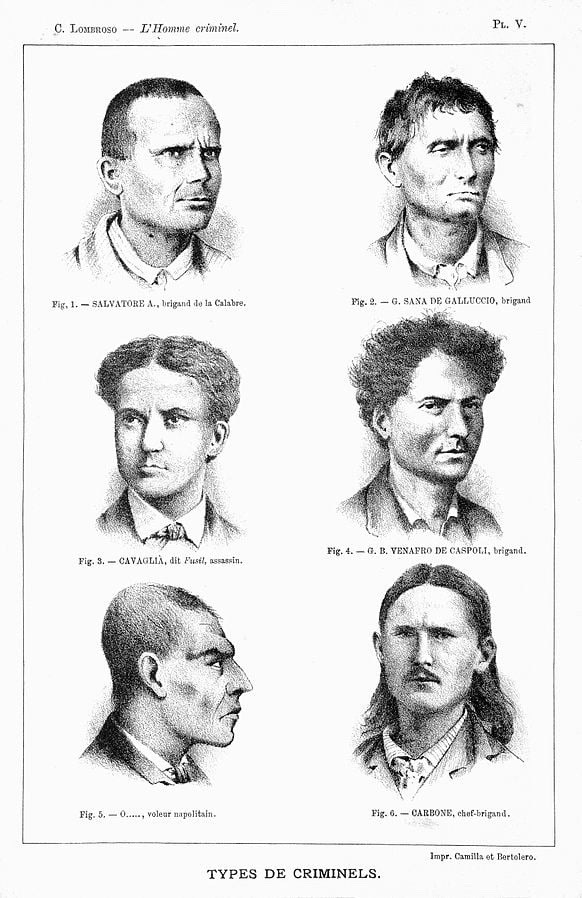

22 notes
·
View notes
Text


Happy wednesday !!🤍
i hope everyone is having a beautiful start to the new year :) starting 2024 with pink notes and a small portion of my desk setup <3
using the kokuyo campus notebook in pink!
#study aesthetic#study notes#aesthetic notes#taking notes#studygram#myhoneststudyblr#studyspo#studyvan#lawdegree#criminology#new year#nye 2024#on wednesdays we wear pink#pink blog#soft pink#aesthetic#pretty things#study inspiration#inspiration#instagram#artists on tumblr#handwriting
444 notes
·
View notes
Text
crimes of the elite: a deep dive
voted on here. (other editions) bold = favourite
corporate harms
behind the smiles at amazon
the long, dark shadow of bhopal (bhopal gas disaster)
how lobbying blocked european safety checks for dangerous medical implants
7-eleven revealed
who controls the world's food supply?
the true cost of tuna: marine observers dying at sea
how a big pharma company stalled a potentially lifesaving vaccine in pursuit of bigger profits
24 years after, some victims not compensated and still can't live normal lives (pfizer's nigeria vaccine trials)
the corporate crime of the century
uber broke laws, duped police and secretly lobbied governments, leak reveals (the uber files)
the baby killer (nestle infant formula scandal)
2 paths of bayer drug in 80's: riskier one steered overseas (hiv-risk contaminated blood product scandal)
global banks defy u.s. crackdowns by serving oligarchs, criminals and terrorists (fincen files)
the ultra-rich
eliminalia: a reputation laundromat for criminals
the fall of the god of cars (international fugitive carlos ghosn)
a u.s. billionaire took over a tropical island pension fund. then hundreds of millions of dollars allegedly went missing (cyprus confidential)
how the wealthiest avoid income tax (the irs files)
the haves and the have-yachts
madoff and his models (madoff ponzi scheme)
the imposter (blockchain terminal fraud)
the ultra-rich: (allegedly) stolen antiquities
crime of the centuries
stolen treasure traders
a hunt for cambodia's looted heritage leads to top museums (pandora papers)
an art crime for the ages
#studyblr#studyspo#student#university#productivity#reading lists#literature#criminology#crime#mydeepdives#i'm working on the lists for state crime and online crime rn!! coming soon hopefully#i will get to all the poll options eventually
318 notes
·
View notes
Text


Spencer and Hotch because I’m rewatching my dvd set
#criminal minds#criminology#house md#aaron hotchner#bau#matthew gray gubler#fanart#artists of tumblr
349 notes
·
View notes
Text
Forensic Odontology Overview

Forensic odontology is a subspecialty of dentistry that has its main focus on the identification of deceased victims. In simplest terms, there are two aims in forensic dentistry. The first one is the identification of the dead, and second is the identification of an assailant who has used his or her teeth as a weapon. But how? Let's see.
Let's start with corpse identification. Teeth can be used to identify corpses, as no two oral cavities are alike, and teeth are unique to an individual. The dental evidence of the deceased recovered from the crime scene is compared with ante-mortem records for identification. This is used in cases such as mass casualties, burn victims, or severely disfigured/decomposed corpses.
Forensic odontology can also be used to determine things like age, race, and sex. In cases where there is no blood or other DNA sources, teeth can also be used.
Age is determined by looking at X-rays of the permanent teeth and tooth roots within the bone. The crown of a tooth forms first, followed by the root, and scientists estimate age by comparing the stage of tooth formation in the X-rays and bone with known dental growth standards.
Race is found by comparing the shapes of the different teeth. Determining race using teeth isn't easy, but using common dental characteristics as indicators (like Caucasoids usually having narrow “v-” shaped arch giving rise to crowding of teeth) we can get a good guess.
To determine sex, we rely on sexual dimorphism. Generally, male teeth have significantly greater quantities of dentine than females, while female teeth are found to have greater enamel thickness than male teeth. This isn't always fully accurate, but when combined with other factors, it helps give an idea.
None of these are perfect, but they can help give us a good approximate description, which is better than none.
Now, Bite Mark analysis.

There's 4 steps to bite mark analysis. Photographs, saliva swabbing, impressions, and tissue samples.
In order to make a good comparison, a balanced, color, scale photograph should be made of the defendant’s teeth (which can be used for testimony in court) and of the victim’s bite. Because the dental expert will need to know the scale shown in the picture, some method of measurement (such as a ruler or tape measure) photographed alongside the bite mark and the defendant’s teeth is necessary. A plaster cast of the defendant’s dental impressions can also be used to prepare a plastic overlay. The plastic overlay is used to mark the points of contact and forms a representation of defendant’s bite marks or a pattern of the cutting edges of defendant’s teeth. This representation can then be compared with a scaled photograph of the bite mark on the victim as a means of determining common points of identification.
If the bite area was swabbed and saliva recovered, and it was a positive match to the subject, that could help identify the assailant, but it's not often that DNA can be recovered.
Bite analysis has its issues, as tooth marks are not always transfered accurately, and sometimes there's not enough difference in bite marks to tell reliably. Bitemark analysis is more often used for excluding someone as a potential assailant. Say the mark shows imprint of fully intact frontal incisors, and the proposed biter does not have all their front teeth. This means that the person being accused is not the probable assailant. This could also be used to tell if the bite was self-inflicted. But bite mark analysis is often not admissible due to it having been found to be unreliable in some cases. People have been rightly and falsely convicted because of it, and it can be an unreliable method for forensic examination.
As with all areas of forensics, it's under dispute for its reputability. Bite mark analysists have been shown to be unable to consistently agree on whether the bitemark was even human. Even minor distortions could lead to the mark matching a number of people.
And here's a little bit of interesting history I came across in my travels :)
There are many "first" uses of forensic odontology in history across the web, but as far as I can find the first documented use of teeth for identification began during 66 AD, with the Agrippina and Lollia Pauline case. (There's a bit to it, find it here.)
Recorded forensic identification in India started in 1193, where Jai Chand, a great Indian monarchy, was destroyed by Muhammad's army, and Jai Chand, Raja of Kanauji was murdered and he was identified by his false teeth.
Dr Ascor Amoedo is reputed as the father of forensic odontology and documented the first case of dental identification in which many individuals lost their lives in a disaster. 126 people were charred to death due to a fire accident in Paris 1897, and were identified using their teeth.
In 1979, a double bite mark played an important role in convicting Ted Bundy of murder as he'd bitten one of his last victims.
#forensics#forensic science#forensic ondontology#dentists#dentistry#sherlock#deductions#science#mortuary science#dexter#criminology#criminals#criminal minds#criminal#criminals minds#woo science#police#idk im kinda using everything#orthodontics#orthodontics near me#AHHAHA#why is that a tag#forensic odontology#odontology#teeth#tma#spencer reid#help im so tired#did this make sense someone tell me it does#history
79 notes
·
View notes
Text
the feminine urge to study criminology
76 notes
·
View notes
Text
general masterlist | Partners in Crime
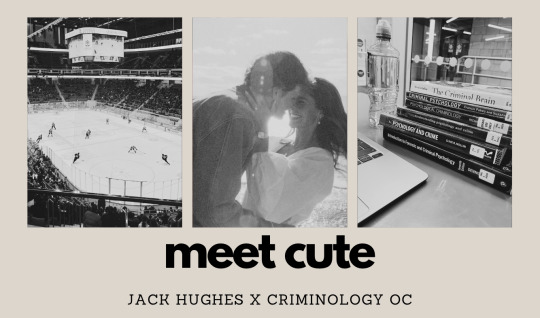
an introduction into just how jack met crim
before all the love and chaos that was to come
Tap tap.
Someone must have just bumped into me.
Tap tap.
"Dahlia..." Bella's shaky voice begins, her eyes wide as she stares just past me.
"What is so surprising beh-" I can't even finish my line of questioning when I turn to see exactly what - more so who - is behind me.
Jack Hughes, number 86 for the Devils, smiling shyly and looking almost adorable in his little beanie.
"Sorry for interrupting, you seemed invested in the game so I figured now would be the best time to come down," He offers, shrugging.
"Um, hi," Is my awkward response.
"Hi," He chuckles, sticking out his hand for me to shake. "I'm Jack."
"I- I know," I stumble, and God I want to crawl inside a hole, "I think everyone in here knows who you are."
"Well, I'm really only hoping to know who you are?" Oh. Is he flirting with me?
"Oh, I'm Dahlia. Dahlia Quigley-Spencer."
"Well, it's nice to meet you Dahlia Quigley-Spencer," He assures, making me smile. "I saw you dancing from our box, and yelling at the refs," Jack begins with a chuckle, gesturing up to the box above us where other injured Devils in beanies are less than discretely looking over the railing at us.
"Do they usually have such a... staring problem?"
The question comes out before I can fully process, Bella snorting behind me as the ever supportive best friend that she is. Jack's laughing nearly as much as she is.
"They tend to be... involved in my life. We're lucky, my brother is on the ice or he'd probably down here too," Jack explains.
"And why is that?" I can't help but ask, hoping it comes off in the flirty way I'm meaning it to.
He smirks, and I can tell my words were taken in at least a small bit how I wanted them to be. "Because I came down to talk to a pretty lady, and he'd want to chirp me about how bad I am at flirting."
"Well I think you're not all that bad, may need a little sprucing up but your smile makes up for it." Oh that earns a blush.
"Really?" He asks cutely, like he's not used to being complemented, which I know isn't true. I can't help but nod, his smile growing. "Thanks, you have a pretty smile too," He returns, bringing a smile to my cheeks.
"Ew, barf, lover boy, are you going to join us or are you going to leave so we can pay attention to the second?" Bella asks, bringing to both Jack's and my attention that the boys are retaking the ice.
It brings an awkward moment to us, unsure of what to happen next.
"Would you like to join us? No one is really around here that might bother you?" I offer, "Also, then you could practice that flirting of yours."
He's smiling, it's a good sign. Body is relaxed, even breathing, he's visually happy.
All very good signs.
"Yeah, I think I'd like that," He agrees, waving up to his friends before taking the seat beside me. "So, are you always so cool when you come to hockey games?"
Bella laughs once more, and I really am regretting bringing her along.
"Am I usually yelling and dancing? Yes," I answer, turning my eyes away from where they had landed on the ice, and on to him. "Am I usually so smoothly flirty? No. I'm currently riddled with anxiety and purely coasting off of that to get me through this conversation."
He laughs, really loud and brightly, which does well to smooth some of my worries at my honesty.
"Well, you're doing great. Think you can handle another two periods of this?"
He's sweet. And I can't help but smile.
This boys is so much more than a hockey player.
"I think I'll be more than okay."
#the writing of spencer rose#original character#nhl fanfiction#jack hughes x oc#jack hughes fanfiction#jack hughes imagine#jack hughes x criminology oc#partner in crime#criminology
72 notes
·
View notes
Text
MY HCS FOR JEFF THE KILLER

These are very dark so scroll if you’re not interested
(Im not involved with fanon, I enjoy looking at psychology and realistic versions of different creeps)
.
.
After killing people Jeff poses their bodies in dehumanising ways.
This is common with lots of serial killers.
Why?
There’s two main purposes behind it:
A) the gratification of the offender
B) to shock those who discover the body (investigators,cops,family etc)
Jeff does it for both those reasons, he wanted to do something to make a statement, a bigger name for himself.He has signature poses for his victims making it so law inforcement know it’s him, he gets off on the fact he’ll never be caught and can piss them off.
One pose Jeff normally places his female victims in is a kneeling pose.
Why?
It demonstrates power.Kneeling in the presence of power means the kneeler is under control, they’re submissive.
He’s sees women as submissive creatures who are weak.
Jeff is putting himself in “Gods role” as the enforcer of mortality (it feeds him solopsistic ideation + god complex)
He doesn’t only use his knife as a weapon, he partakes in strangulation
Strangulation, particularly ligature strangulation, is more commonly associated with sexual sadistic murderers than non sexual sadistic murderers.
Jeff is a non sexual sadistic murderer.
Why does he do it?
It allowed the perpetrator to exert more power over their victims, that is what Jeff enjoys.
Being able to see the light drain from their eyes at the mercy of his hands,how they fail to fight back? Absolutely, sign him up.

Thank you for reading, again I’m apologising for not answering asks, I’m busy writing my fanfic at the minute! I will come on occasionally and answer some like I’ve been doing <3 I don’t want to rush them I wanna think them over! Thank you for being patient :)
#creepypasta#creepypasta fandom#hcs#realistic#alternate universe#horror#slenderman#headcanons requests#jeff the killer#jeffery woods#jtk#psychology#criminology
120 notes
·
View notes
Text
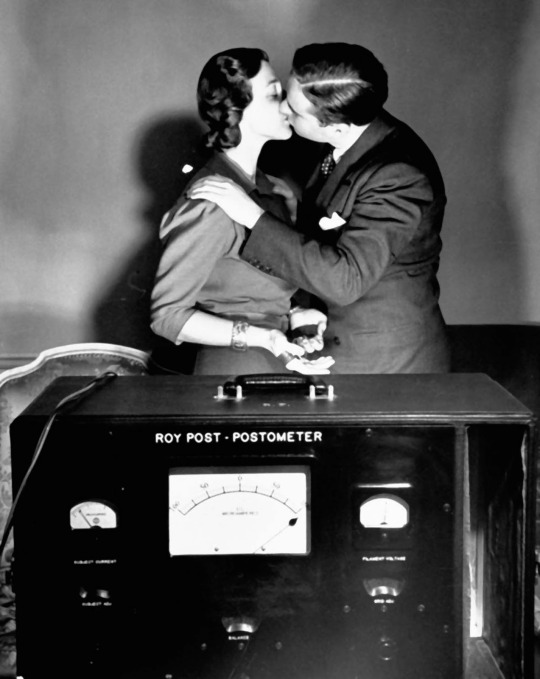
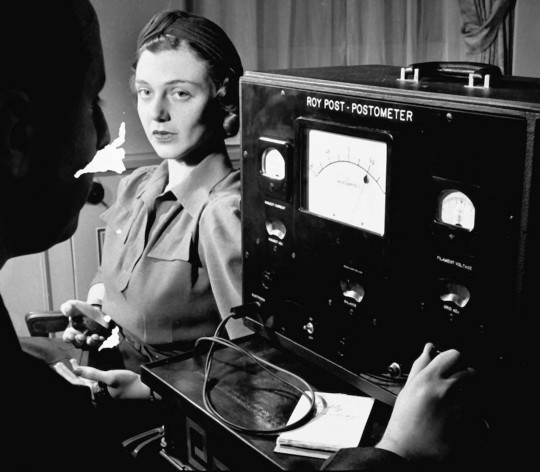

NYPD criminologist Roy Post invented his own version of a lie detector machine. Called The Postometer, the test theoretically detected not only criminal suspects, but also discovered the truth, or otherwise, of people’s reactions to emotional stimulus. [1939]
#documentary photography#retro tech#innovation#criminology#technology#black and white#monochrome#roy post#the postometer#30s#photography#u
70 notes
·
View notes
Text
listening to classical music while losing my mind over my assignment i feel half like richard papen (losing my mind) & half like henry winter (listening to classical music)
#literature#send help#dark academia#the secret history#henry winter#richard papen#exam season#winter#psychology#criminology#classics#classical music
69 notes
·
View notes
Text

Jeffrey Dahmer’s apartment. (Top complex)
After he was caught on July 22nd 1991 the police discovered body parts, bones, and corpses of 11 people in his apartment. They also found all kinds of knives and sawblades, a hypodermic needle, an electric drill, a 57 gallon blue plastic drum with three decomposing torsos inside and photographs of his mutelited victims.
#my upload#found on pinterest#jeffrey dahmer#true crime#tcc#tc community#true crime community#morbid#interesting#disturbing#evan peters#ted bundy#richard ramirez#dark aesthetic#insane#psychology#psychopath#criminology
808 notes
·
View notes
Text
Applying criminological theories to Phantom of the Opera #1
I study criminology, and I have an exam in a week about criminological theories (=theories that attempt to explain deviant behavior/crime.) Each theory has a different perspective. So, I figured, why not apply a theory to Phantom. It's been on my mind.
For example, there's Classical Strain Theory (Merton, 1938). It was developed as a criticism of the 'American Dream.' Merton argued that not everyone can achieve the ideals of the American Dream (ex: a good house, good job, nice salary). I mean, if you're born into a poor family, of course it's much harder to get to a top university and become a lawyer. So, he argued, that the people who don't have the means to achieve society's goals, experience "strain". An individual responds to strain in different ways. They respond differently in different situations.
🎭 "Conformity"
An individual accepts the goal (example: American Dream) and try to achieve it with socially accepted means anyway. So, they try to 'work hard' and follow 'legitimate routes.'
🔪 "Innovation"
An individual accepts the goals, but they try to use different - absolutely not socially accepted - means. Innovation! You could get rich by working hard, but you could also steal things or extort people. And this is exactly what Erik does. Let's apply this element of strain theory to him. One of his society's goals is to, as a man, have a steady job and make money. Erik isn't able to achieve this goal due to his face. He's stigmatised and ridiculed for it. He doesn't have a face that's allowed in a workspace. Not to mention that his upbringing caused him to be socially unskilled, and he generally has some odd traits that make him unable to keep a job. That causes a lot of strain. The dude can't achieve his goals. Thus, to achieve society's goal anyway, he starts to manipulate and extort the managers of the opera house. In that way, he's achieved the goal of making money, just differently (and through criminal behavior). There are probably more examples of Erik's innovations, but I want to explain the other responses to strain too.
🥀 "Ritualism"
Ritualism is another response. This is when you accept society's goals, but you don't have the means to achieve them, and you basically give up on trying. An example is an exhausted person working a thankless job, never trying to move up the hierachy within their company. They have kinda accepted their fate, and accepted that they don't have the means to grow into a better position. This can also be applied to Erik, especially to the very moment he starts living inside the opera house. One could say his goals are to get a (1) nice-looking house and (2) become a 'normal,' functioning member of society. Clearly, Erik's tried to achieve these goals in his past; he's travelled around the world, and one could say he attempted to find a steady homebase everywhere he went. He's worked different jobs (circus-artist, architect, assassin), trying to become a functioning member of society the way society wants it. But again, there's an obstacle each time he tries to be 'normal': his face. Everyone rejects and abuses him. So, he gives up on becoming a functioning member of society, also deciding to accept he won't have a nice house, nor a nice job. He hides himself in the opera house and 'functions' from the background, from the shadows. His reality is an unfortunate reality for a lot of neurodivergent and disabled folks too.
🕳️ "Retreatism"
This is when someone also gives up, but they retreat from society altogether in a literal sense. Merton mentions severe drug-addicts and homeless folks as an example of this. These folks don't have the means to achieve society's goals, so they give up on them and retreat from society. They're technically 'there', but not a part of it; they don't 'function' at all anymore, according to Merton. And Erik's a fine example of this during the last scene of Phantom. He lets Christine go, giving up on trying to achieve society's goals of getting a nice family, a house, a wife... But it's no use. It's implied he withers away from sadness and dies. He gives up and retreats - unfortunately resulting in death.
✊ "Rebellion"
This is when you can't achieve society's goals, so you reject them and try to reform society. Merton mentions terrorists as an example of this. However, I could argue that activists or protestors are also an example of it - without correlating them to the extreme example of terrorists. Erik rebels a lot in the show, but I want to focus on the moment he drops the chandelier onto an audience, killing them. One of society's goals is to make money, like I mentioned before. Erik does this, by innovation; he extorts the managers for 20 000s francs each month. They pay him, up until they start to reject his extorting. Christine also rejects (and 'betrays') him, ruining their teacher-student dynamic. He can't be her teacher any longer and he probably won't get to marry her either. He can't achieve the aforementioned goals of being a functioning member of society, plus marrying someone, which is another goal. So, acting out, he drops the chandelier on a bunch people, killing them horribly. This shows he rejects society's goals and the means to achieve them.
Criticism
Of course Merton's theory is an old one, and he only applied it to the American Dream. It's also hard to test this theory, because how do you measure strain? It also doesn't explain specifically what makes some individuals resort to crime, and what makes others conform. Therefore it also doesn't account for the emotional state of an individual, and how much "strain" they can handle. I mean, Erik's clearly damaged emotionally, causing him to have moments where he acts completely irrationally. This is evident when he chokes Christine for a moment in the musical, but stops when he 'comes to his senses.' Is Erik's criminal behavior a result of strain, or a result of other factors, like mental illness, or even brain damage due to the abuse he endured?
But all in all, it's an interesting theory and it's fun to apply it to characters. And now, I have to go back to studying again. See ya (:.
#phantom of the opera#poto#my thoughts#erik the phantom#phantom#robert merton#strain theory#strain#criminology#crime#fictional crime
94 notes
·
View notes
Text
My best friend came to help me with my notes today 🐱 the fluffy paws were all the motivation I needed to get these pages done!
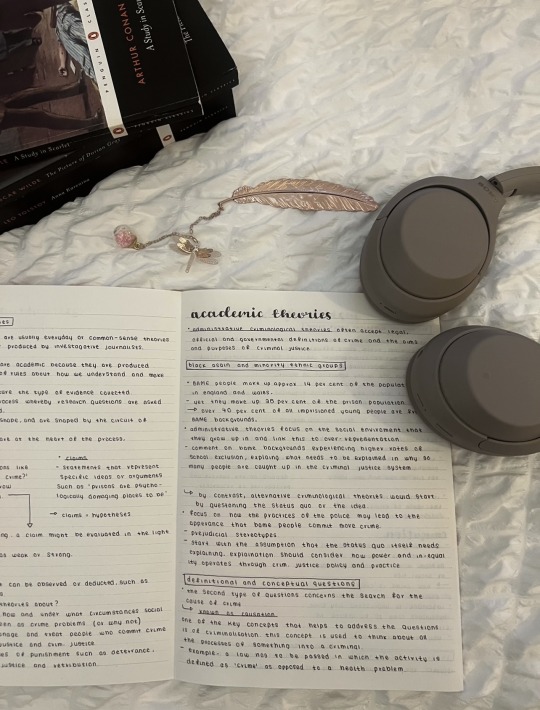

Hope everyone has a productive day! :)
#study aesthetic#study notes#aesthetic notes#taking notes#studygram#myhoneststudyblr#studyspo#college#medicine#criminology#lawdegree#headphones#books & libraries#classic#college student#university student#notes#revising
554 notes
·
View notes
Text
crimes in the online space: a deep dive
voted on here. (other editions) bold = favourite
scams, hacks, & financial crime
the romance scammer on my sofa
the incredible rise of north korea's hacking army
heartbreaker
the fall of the billionaire gucci master
to catch a catfish
for trafficking victims forced to scam others, the nightmare continues even after escape
the great cyberheist
crying spouses and fake profiles: how the ashley madison hack changed everything
the dark web
hunting warhead
inside the fbi takedown of the mastermind behind website offering drugs, guns and murders for hire
merchant of death (pro-suicide forums)
the hunt for the dark web's biggest kingpin
the takedown of a dark web marketplace
the exploitation of women & children
she helped expose girls do porn, but she can never outrun what it did to her
catching the men who sell subway groping videos
how facebook and instagram became marketplaces for child sex trafficking
how police cracked canada's largest child pornography ring
'i log into a torture chamber each day': the strain of moderating social media
the child exchange
#studyblr#studyspo#productivity#academia#university#reading list#reading lists#literature#criminology#crime#mydeepdives
94 notes
·
View notes
Text

How i look explaining mental illness statistics to the hoes
171 notes
·
View notes
Text
Algae and Forensics
If you watch a lot of crime shows, you may have seen algae being used to help solve a crime. In Dexter, the algae on the victims was used to determine the port they came from, which led them to Dexter. Or Hannibal, where the algae led the FBI to Miriam Lass. A lot of crime shows play forensics up, but algae actually can be an important tool for helping solve a crime.
The presence of algae, or lack thereof, can tell us several things. Is there algae present in the closed organs of the decedent? If so, that tells you they were drowned or whether or not they were taken to a second location. What kind of algae? This can help us determine fairly accurately where the victim was drowned. This doesn't include bathwater or water with too few diatoms, such as ice water.
But how? Let's look into that.

First off, I will be using the term "Diatoms." If you are unaware, diatoms are a type of photosynthesising algae, so I will be using the terms interchangeably.
There are over 15,000 species of algae living in brackish, fresh water, and sea water. Ponds, lakes, rivers, oceans, and coastal areas all have different diatom communities, and using that we can identify where the victim might have been killed.
When you drown, liquid is aspirated into the lungs and enters the bloodstream through alveoli. This lets particles such as sediments, microorganisms, or pollen to be carried to organs and deposited in capillaries. This means that diatoms can be found in the organs of a drown victim.
So, if diatoms are found in distant organs or closed systems and are of a great abundance, the cause of death is most likely due to ante-mortem drowning. This lets us know that the victim was drowned and was not just dumped posthumously.
Thanks to diatoms acid resistant sillica shell, they can easily be separated from tissue using acid-digestive extractions, and they are detectable in burned or putrified corpses. This means that drowning as a cause of death could be determined in a burnt victim that was taken to a second location.

Algae is also being researched for its use as a time of death indicator. A study was conducted by forensic scientists, who found the diversity of algae on piglet bodies in water tended to decrease over time with a peak in diatoms recorded after 1-8 days of decomposition. This kind of work remains largely experimental, but it has the potential to be used for establishing a timeline since death (or submersion) in water.
Algae can be useful for linking criminals to their crime scenes, as diatoms can transfer onto clothing or footwear. Comparing microflora with the diatoms found could also give you a general area or type of water they were drowned in, as a swamp would have different algae than say, the ocean.
This evidence isn't damning in and of itself, but all evidence at a crime scene is valuable for solving the crime, and as such, algae can be an important part of forensics.
Thanks for reading! Have a good day and a cup of tea :)
#forensics#dexter#sherlock#forensic science#mortuary science#algae#my favorite thing in the whole world is the intersection of forensics and marine biology#marine biology#biology#marine flora#✨️science✨️#djxbbdshhshsn#im tired as fuck#not that anyone asked#:>#criminologist#criminology#crime#crime solving#with ✨️forensics ✨️#woo#sherlockian#deduction#science of deduction#deductionist#deductive reasoning#marine biologist#marine life#microflora
60 notes
·
View notes